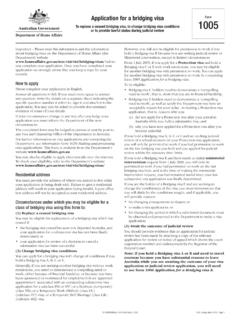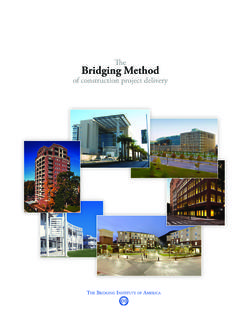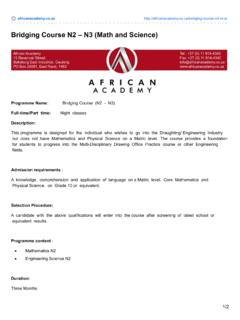Transcription of Bridging the Opportunity Divide for Low- Income …
1 Bridging the Opportunity Divide for Low- Income Youth: Implementation and Early Impacts of the Year Up Program Executive Summary May 2018 OPRE Report #2018-65 Bridging the Opportunity Divide for Low- Income Youth: Implementation and Early Impacts of the Year Up Program Pathways for Advancing Careers and Education (PACE) OPRE Report #2018-65 May 2018 David Fein and Jill Hamadyk, Abt Associates Submitted to: Nicole Constance Federal Project Officer Office of Planning, Research, and Evaluation Administration for Children and Families Department of Health and Human Services Contract No. HHSP2332007913YC Project Director: Karen Gardiner Abt Associates Inc. 4550 Montgomery Ave. Bethesda, MD 20814 This report is in the public domain. Permission to reproduce is not necessary. Suggested citation: Fein, D. and Hamadyk, J. (2018).
2 Bridging the Opportunity Divide for Low- Income Youth: Implementation and Early Impacts of t he Year Up Program, OPRE Report #2018-65, Washington, DC: Office of Planning, Research, and Evaluation, Administration for Children and Families, Department of Health and Human Services. To contact the first author, e-mail Disclaimer The views expressed in this publication do not necessarily reflect the views or policies of the Office of Planning, Research, and Evaluation, the Administration for Children and Families, or the Department of Health and Human Services. This report and other reports sponsored by the Office of Planning, Research, and Evaluation are available at Year Up Implementation and Early Impact Report PACE Abt Associates Executive Summary pg. i Executive Summary As opportunities for college graduates have grown in recent decades, prospects for young adults without postsecondary credentials have steadily worsened.
3 With few chances at well-paying jobs, many give up on school and withdraw from the labor force. Short spells of withdrawal often lead to long-term disconnection and life-long disadvantages. The societal costs are high: lack of Opportunity is associated with higher rates of crime, substance abuse, health problems, single parenting, and economic dependency. Tax revenues are diminished, and employers are deprived of millions of workers needed to close skills gaps in growing This report provides encouraging evidence on the implementation and early impacts of Year Up a national sectoral training program for urban young adults aged 18-24 with a high school diploma or equivalent. Operated by an organization of the same name, Year Up provides six months of full-time customized training in the IT and financial service sectors followed by six-month internships at major firms.
4 The full-time program provides extensive supports including weekly stipends and puts a heavy emphasis on professional, as well as technical, skills. Employer payments to Year Up for interns financed 59 percent of the program s $28,290 per participant cost. The program grew rapidly following its inception in Boston in 2000, increasing both in the number and size of local offices. During the study period 2013-2014 Year Up served over 3,500 young adults in eight metropolitan areas. Year Up is one of nine programs Abt Associates is evaluating in the federally sponsored Pathways for Advancing Careers and Education (PACE) evaluation. Each of the nine evaluations includes implementation and impact studies. For the Year Up study, the evaluation team randomly assigned 2,544 young adults to treatment (1,669) and control (875) groups. This report covers the program s implementation and early impacts, with follow-up centering on years and extending to 3 years for some outcomes.
5 Future reports will examine program impacts for up to 6 years after program entry and include analyses of the program s costs and benefits. Findings show that Year Up implemented its program with high fidelity to its design and substantially increased the training, support, and employment services young adults received. It had a large positive impact on the confirmatory outcome selected for this report average quarterly earnings in the sixth and seventh quarters after random assignment. Average quarterly earnings were $1,895 higher for the treatment group ($5,454) than for the control group ($3,559) a 53 percent impact. Impacts diminished but remained large (about 40 percent) over the following year. As documented briefly in this summary and at more length in Chapter 1, these earnings impacts are the largest reported to date for workforce programs tested using a randomized controlled trial (RCT) design.
6 1 See Chapter 1 for literature review and citations. Year Up Implementation and Early Impact Report PACE Abt Associates Executive Summary pg. ii Program Overview Gerald Chertavian founded Year Up in 2000 to serve economically disadvantaged urban young adults ages 18 to The program targets young adults with a high school diploma or equivalent who are motivated and who, with assistance, can overcome challenges and successfully enter careers in fast-growing technical occupations. Year Up and other advocates have labeled this population Opportunity Youth to emphasize the positive contributions they could make, given effective interventions. Year Up s original model which it calls the core program is a free-standing program operating in eight urban areas: Atlanta, Boston, Chicago, New York, Providence, the San Francisco-San Jose Bay Area, Seattle, and Washington DC.
7 Abt Associates is evaluating the core program in all eight locations for The program teaches students high demand technical and professional skills, connects them with employers, and provides college credits via agreements with local college partners. A national team headquartered in Boston provides operations assistance ( , human resources, marketing, and accounting); facilitates cross-site knowledge building; and provides oversight and troubleshooting of local implementation. Payments from employers for interns cover 59 percent of Year Up s costs. Nearly all of the balance (39 percent) of revenue comes from foundations and other private-sector donors, and only two percent is from public agencies. Recruiting from the general community, the program enrolls participants twice (in March and September) each year. During the first six months of the program the Learning and Development (L&D) Phase students attend courses at Year Up full-time.
8 Training addresses both occupation-specific and general skills. The focus of technical training varies by office and cohort. Fields include information technology (IT, the most common emphasis), business operations, financial operations, software development, and sales and customer support. General skills courses focus on professional and business communications skills. Students gain experience in writing, giving presentations, interacting with clients and colleagues, and developing critical thinking skills. Year Up sites work with local partner colleges so that students can earn college credit for their participation in Year Up. Year Up provides a very consistent structure..[I]t s not loose. You know what to expect: [the hours are] 8:30-3:30, your stipend is this, and [there is] a particular routine. Some of our young people are coming from environments where there was never a routine: you could show up at high school or not show up, do whatever you want to do.
9 But Year Up creates a culture similar to the culture we are trying to have them assimilate in. Year Up staff member 2 See Chertavian (2012) on Year Up s founding and development. 3 Since launching the PACE evaluation, Year Up also has launched pilots of an adaptation of the core program for college settings the Professional Training Corps (PTC) aimed at reducing costs and enhancing scalability. Abt Associates is collaborating with researchers at the University of Pennsylvania and Year Up on a separate evaluation of PTC. Year Up Implementation and Early Impact Report PACE Abt Associates Executive Summary pg. iii Year Up s high support, high expectations model provides extensive services and sets high standards for professional behavior. Each incoming cohort of young adults is organized into groups of about 40 students and staff called learning communities to foster supportive social connections.
10 All participants receive advising from Year Up staff members, and every staff member is expected to serve as a student advisor/coach in addition to other duties. Participants also receive mentoring from outside professionals working in related occupations. Each local office maintains a team of social workers who provide direct services and referrals to help students address varied life challenges. Students receive weekly stipends (typically $150 during the first half and $220 during the second half of the program) to help cover transportation and other program-related expenses. Students sign a formal contract specifying standards for professional behavior. Infractions trigger stipend reductions and can lead to dismissal from the program. The program teaches techniques for constructively giving and receiving feedback. It hones these skills in Friday feedback sessions and encourages practice throughout the week.







